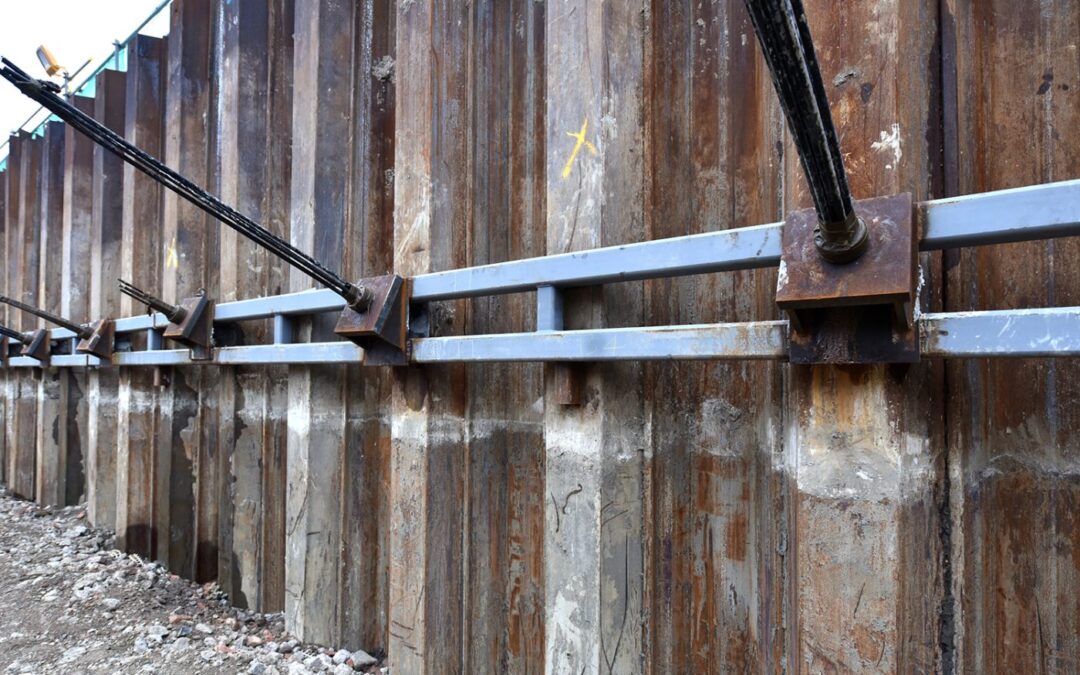Sheet pile retaining walls, a fundamental element in civil engineering and construction, play a crucial role in stabilizing soil and preventing erosion. This article delves into the key features, engineering principles, applications, and advantages of sheet pile retaining walls, shedding light on the significance of these structures in creating stable and efficient earth retention solutions.
Introduction to Sheet Pile Retaining Walls:
Sheet pile retaining wall are vertical barriers that use interlocking steel or concrete sheet piles to create a structural barrier against soil or water pressure. These walls are widely employed in scenarios where the excavation depth is deep, and space constraints necessitate a vertical solution to retain earth or water.
Engineering Principles:
The engineering principles behind sheet pile retaining walls involve leveraging the strength and interlocking capabilities of the sheet piles. The piles driven into the ground to create a continuous wall, forming a barrier that resists lateral soil pressure. The wall’s effectiveness lies in its ability to distribute loads and maintain stability in various soil conditions.
Types of Sheet Piles:
Sheet piles come in various materials, shapes, and configurations to suit different project requirements. Common types include:
Steel Sheet Piles: Robust and versatile, steel sheet piles are widely used for their strength and durability. They come in various profiles, including U-shaped, Z-shaped, and straight-web sections.
Concrete Sheet Piles: Reinforced with steel for added strength, concrete sheet piles are suitable for applications where corrosion resistance is a primary concern. They offer durability and environmental sustainability.
Vinyl Sheet Piles: Vinyl sheet piles are lightweight, corrosion-resistant, and environmentally friendly. They are often used in projects with specific requirements, such as seawalls or waterfront structures.
Installation Process:
The installation of sheet pile retaining wall involves a meticulous process:
Driving Piles: The sheet piles driven into the ground using vibratory hammers, impact hammers, or hydraulic presses. The choice of equipment depends on soil conditions and project specifications.
Interlocking: Sheet piles design to interlock seamlessly, creating a continuous barrier. The interlocking mechanism enhances the wall’s stability and resistance to lateral pressures.
Anchoring: To further enhance stability, sheet pile retaining walls may anchored using tiebacks or soil anchors. These provide additional support, particularly in situations with high lateral loads.
Applications of Sheet Pile Retaining Walls:
Sheet pile retaining wall find applications in various construction scenarios:
Waterfront Structures: Sheet piles commonly use in the construction of seawalls, bulkheads, and quay walls to protect coastal areas from erosion and provide stability against water pressure.
Bridge Abutments: Sheet pile retaining wall supports bridge abutments by preventing soil erosion and maintaining stability in the surrounding areas.
Excavation Support: In urban construction projects with limited space. Sheet piles use for excavation support to prevent soil collapse and ensure the safety of adjacent structures.
Basement Retention: Sheet pile retaining wall employ in the construction of basements to stabilize soil and create space below ground level.
Advantages of Sheet Pile Retaining Walls:
Cost-Effectiveness: Sheet pile retaining wall are often more cost-effective compared to alternative retaining wall systems, especially in projects with deep excavations.
Versatility: Sheet piles can customized to suit various project requirements, and their interlocking design allows for flexibility in adapting to different soil conditions.
Rapid Installation: The installation process for sheet pile retaining walls is typically faster than alternative methods, contributing to overall project efficiency.
Durability: Steel and concrete sheet piles are durable and resistant to environmental factors, ensuring the longevity of the retaining wall.
Considerations and Challenges:
While sheet pile retaining walls offer numerous advantages. It’s essential to consider factors such as corrosion protection for steel sheet piles. Environmental impact, and the potential for noise and vibration during installation. Site-specific challenges, such as soil conditions and water table levels, must carefully addressed during the design and construction phases.
Conclusion:
Sheet pile retaining walls stand as engineering marvels that provide stability, prevent erosion, and maximize space utilization in construction projects. From waterfront structures to urban excavations, their versatility, cost-effectiveness, and rapid installation make them a preferred choice in civil engineering. As technology and materials continue to advance. Sheet pile retaining wall will likely remain a cornerstone in the realm of earth retention solutions, contributing to the safe and efficient development of various structures and infrastructures.

